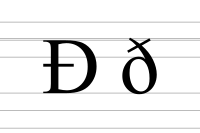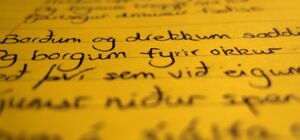Ð
| Ð | |
|---|---|
| Ð ð | |
 | |
| الاستخدام | |
| نظام الكتابة | Latin script |
| النوع | Alphabetic and Logographic |
| لغة المنشأ | Old English language Old Norse language |
| القيم الصوتية | [ð] [θ] [ð̠] /ˈɛð/ |
| في اليونيكود | U+00D0, U+00F0 |
| التاريخ | |
| التطور | |
| الفترة الزمنية | ~800 to present |
| السلالة | Đđ |
| الشقيقات | None |
| مكافئات الترجمة الحرفية | d |
| أخرى | |
| الرسوم المقترنة | th, dh |
إث (إنگليزية: Eth؛ /ɛð/ edh, uppercase: Ð, lowercase: ð; also spelled edh or eð), known as ðæt in Old English,[1] is a letter used in Old English, Middle English, Icelandic, Faroese (in which it is called edd), and Elfdalian.
It was also used in Scandinavia during the Middle Ages, but was subsequently replaced with ⟨dh⟩, and later ⟨d⟩.
It is often transliterated as ⟨d⟩.
The lowercase version has been adopted to represent a voiced dental fricative in the International Phonetic Alphabet.
الإنجليزية القديمة
In Old English, ⟨ð⟩ (called ðæt) was used interchangeably with ⟨þ⟩ to represent the Old English dental fricative phoneme /θ/ or its allophone /ð/, which exist in modern English phonology as the voiced and voiceless dental fricatives both now spelled ⟨th⟩.
Unlike the runic letter ⟨þ⟩, ⟨ð⟩ is a modified Roman letter. Neither ⟨ð⟩ nor ⟨þ⟩ was found in the earliest records of Old English. A study of Mercian royal diplomas found that ⟨ð⟩ (along with ⟨đ⟩) began to emerge in the early 8th century, with ⟨ð⟩ becoming strongly preferred by the 780s.[2] Another source indicates that the letter is "derived from Irish writing".[3]
Under King Alfred the Great, ⟨þ⟩ grew greatly in popularity and started to overtake ⟨ð⟩. ⟨Þ⟩ completely overtook ⟨ð⟩ by Middle English, and ⟨þ⟩ died out by Early Modern English, mostly due to the rise of the printing press,[4] and was replaced by the digraph th.
الآيسلندية
In Icelandic, ⟨ð⟩, called "eð", represents an alveolar non-sibilant fricative, voiced [ð̠] intervocalically and word-finally, and voiceless [θ̠] otherwise, which form one phoneme, /θ/. Generally, /θ/ is represented by thorn ⟨Þ⟩ at the beginning of words and by ⟨ð⟩ elsewhere. The ⟨ð⟩ in the name of the letter is devoiced in the nominative and accusative cases: [ɛθ̠]. In the Icelandic alphabet, ⟨ð⟩ follows ⟨d⟩.
لغة فارو
In Faroese, ⟨ð⟩ is not assigned to any particular phoneme and appears mostly for etymological reasons, but it indicates most glides. When ⟨ð⟩ appears before ⟨r⟩, it is in a few words pronounced [ɡ]. In the Faroese alphabet, ⟨ð⟩ follows ⟨d⟩.
النرويجية
In Olav Jakobsen Høyem's version of Nynorsk based on Trøndersk, ⟨ð⟩ was always silent, and was introduced for etymological reasons.
الويلزية
⟨Ð⟩ has also been used by some in written Welsh to represent /ð/, which is normally represented as dd.[5]
الخمير
⟨Ð⟩ is sometimes used in Khmer romanization to represent ឍ thô.
التدوين الصوتي
U+00F0 ð latin small letter eth represents a voiced dental fricative in the International Phonetic Alphabet.
U+1D9E ᶞ modifier letter small eth is used in phonetic transcription.[6]
U+1D06 ᴆ latin letter small capital eth is used in the Uralic Phonetic Alphabet.[7]
الإدخال في الحاسوب
The Faroese and Icelandic keyboard layouts have a dedicated button for eth.
On Microsoft Windows, eth can be typed using the alt code Alt+(0240) for lowercase or Alt+(0208) for uppercase, or by typing AltGr+d using the US International keyboard layout. On Windows 10, it can also be inserted into text via the symbol menu, presented by using Windows+; or Windows+. then selecting Symbols, associated with the Omega (Ω) character, and then selecting Latin Symbols, associated with the C-cedilla (Ç) character.
Using the compose key ("multi key") which is popular on Linux, eth can be typed by typing Compose D H for lowercase or Compose ⇧ Shift+D ⇧ Shift+H for capital letters.
On ChromeOS with 'extended keyboard' Chrome extension, AltGr+D will result in ð being displayed; ⇧ Shift+AltGr+D will result in Ð.
غيرها
| System | Uppercase | Lowercase |
|---|---|---|
| Unicode | U+00D0 | U+00F0 |
| HTML | Ð |
ð
|
| TeX/LaTeX | \DH |
\dh
|
| GTK | Ctrl+⇧ Shift+U D0 ↵ Enter | Ctrl+⇧ Shift+U F0 ↵ Enter |
| Vim[8] | Ctrl+K ⇧ Shift+D - | Ctrl+K D - |
الاستخدامات الحديثة
- The letter ð is sometimes used in mathematics and engineering textbooks, as a symbol for a spin-weighted partial derivative.
This operator gives rise to spin-weighted spherical harmonics.
انظر أيضاً
المراجع
- ^ Marsden, Richard (2004). The Cambridge Old English Reader. Cambridge University Press. p. xxix.
- ^ Shaw, Philip (2013). "Adapting the Roman alphabet for writing Old English: evidence from coin epigraphy and single-sheet charters". Early Medieval Europe. 21 (2): 115–139. doi:10.1111/emed.12012. S2CID 163075636.
- ^ Freeborn, Dennis (1992). From Old English to Standard English. London: Macmillan. p. 24. ISBN 9780776604695.
- ^ Hill, Will (30 June 2020). "Chapter 25: Typography and the printed English text" (PDF). The Routledge Handbook of the English Writing System. p. 6. ISBN 9780367581565.
The types used by Caxton and his contemporaries originated in Holland and Belgium, and did not provide for the continuing use of elements of the Old English alphabet such as thorn <þ>, eth <ð>, and yogh <ʒ>. The substitution of visually similar typographic forms has led to some anomalies which persist to this day in the reprinting of archaic texts and the spelling of regional words. The widely misunderstood 'ye' occurs through a habit of printer's usage that originates in Caxton's time, when printers would substitute the <y> (often accompanied by a superscript <e>) in place of the thorn <þ> or the eth <ð>, both of which were used to denote both the voiced and non-voiced sounds, /ð/ and /θ/ (Anderson, D. (1969) The Art of Written Forms. New York: Holt, Rinehart and Winston, p 169)
- ^ Testament Newydd (1567), http://people.pwf.cam.ac.uk/dwew2/hcwl/t/webconc/t100.htm, retrieved on 2011-01-30.
- ^ Constable, Peter (2004-04-19). "L2/04-132 Proposal to add additional phonetic characters to the UCS" (PDF).
- ^ Everson, Michael; et al. (2002-03-20). "L2/02-141: Uralic Phonetic Alphabet characters for the UCS" (PDF).
- ^ "Vim documentation: digraph".
- ^ "README.md". Dogecoin Integration/Staging Tree (Source code). February 5, 2014. Retrieved 17 February 2014.
للاستزادة
- Ladefoged, Peter; Maddieson, Ian (1996). The Sounds of the World's Languages. Oxford: Blackwell. ISBN 0-631-19815-6.
- Pétursson, Magnus (1971), "Étude de la réalisation des consonnes islandaises þ, ð, s, dans la prononciation d'un sujet islandais à partir de la radiocinématographie", Phonetica 33 (4): 203–216, doi:
وصلات خارجية
- "Thorn and eth: how to get them right", Operinan, Briem, http://66.147.242.192/~operinan/2/2.11/index.htm, retrieved on 2010-08-22
- "Älvdalsk ortografi" (in sv), Förslag till en enhetlig stavning för älvdalska, February 2007, http://www.alvdalen.se/alvdalska/alvdalsk_ortografi.pdf.
| الأبجدية اللاتينية المعاصرة الأساسية | |||||||||||||||||||||||||
|---|---|---|---|---|---|---|---|---|---|---|---|---|---|---|---|---|---|---|---|---|---|---|---|---|---|
| Aa | Bb | Cc | Dd | Ee | Ff | Gg | Hh | Ii | Jj | Kk | Ll | Mm | Nn | Oo | Pp | Rr | Ss | Tt | Uu | Vv | Ww | Xx | Yy | Zz | |
|
التاريخ • علم الخطاطة • المشتقات • التشكيل • punctuation • الأرقام • يونيكود • قائمة الحروف • ISO/IEC 646 | |||||||||||||||||||||||||
- Short description is different from Wikidata
- Articles with hatnote templates targeting a nonexistent page
- Articles with redirect hatnotes needing review
- Missing redirects
- Pages with plain IPA
- Articles containing إنگليزية-language text
- Pages using Lang-xx templates
- Articles containing إنگليزية القديمة (ح. 450-1100)-language text
- Articles containing آيسلندية-language text
- Articles containing Nynorsk-language text
- Articles containing خمير وسطى-language text
- Faroese language
- Gaulish language
- Icelandic language
- Middle English
- Old English
- Old Norse
- Palaeographic letters
- Phonetic transcription symbols
- Latin-script letters
- English th

